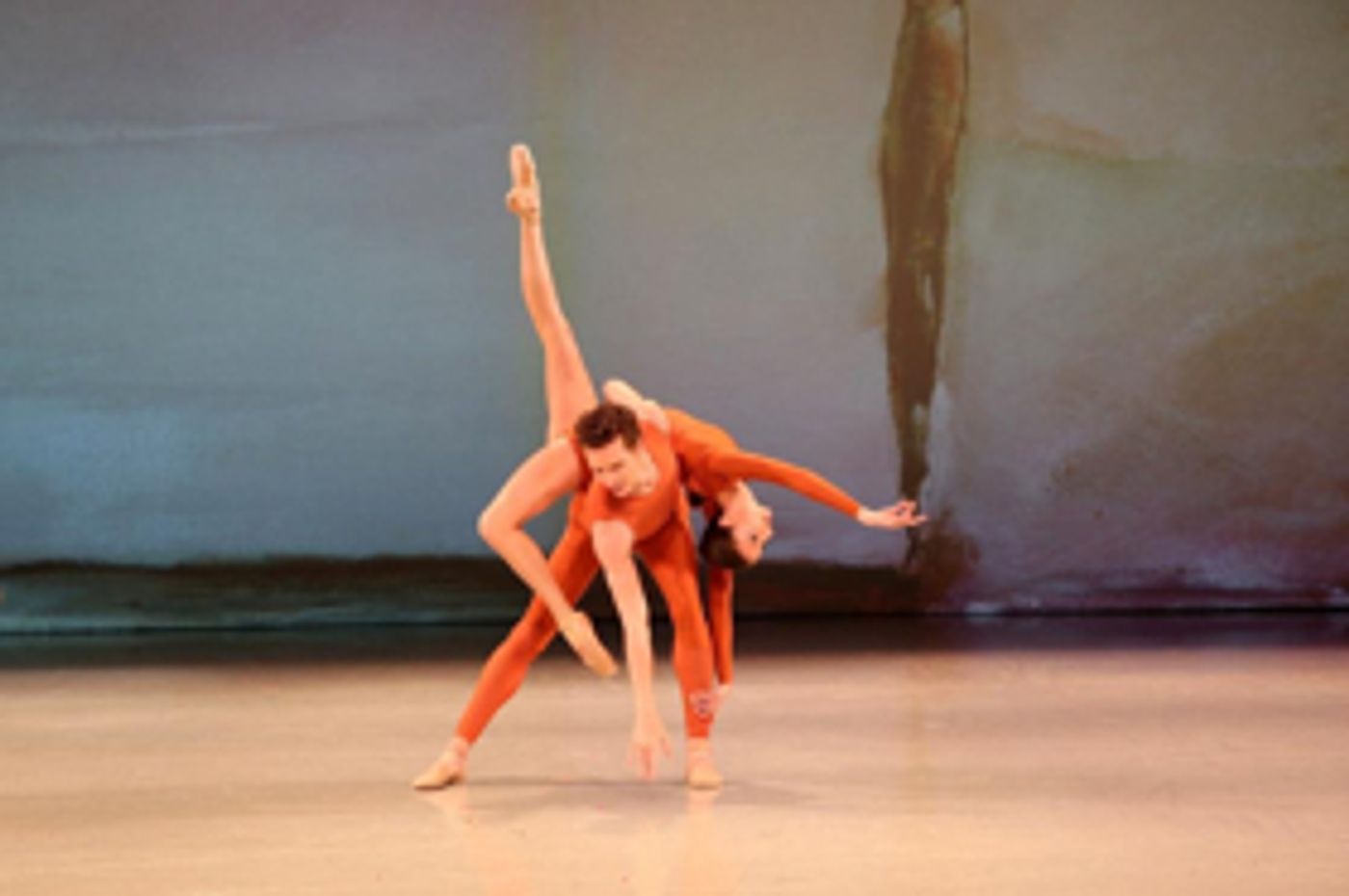Review: Richmond Ballet New Works Festival

Richmond Ballet's decade-long running New Works Festival included pieces by Francesca Harper, Tom Mattingly, Mariana Oliveira, and Bradley Shelver. Each choreographer received twenty-five rehearsal hours to create a new work on the company. Shelver described the process (in a pre-performance video introduction) as condensing the intimacy and knowledge of a "ten year relationship into one week." Performances took place at the company's home studios, a casual but intimate experience.
Former company dancer Tom Mattingly's Figure in the Distance opened the evening with Taylor A. Moore's visual artwork, The Dancer, projected on the backdrop. Mattingly described the work as focusing on the "idealized version of who I want to be." It began in silence (later accompanied by Philip Glass' Concerto for Violin and Orchestra). Two dancers in semi-sheer orange leotards slowly walked across the stage. Dancers stepped deliberately on each foot (at changing paces throughout the work) which made walking somewhat of a balancing act. Mattingly used oppositional movement. Torsos twisted, limbs crossed the body, attitude turns - the side attitude turns stunned, and rond de jambes became connecting, transition steps. Mattingly employed trios and brief tableaus. To conclude, couples moved in uniform steps and lifts in attitude. The pace slowed, the stage emptied, leaving Lauren Archer and Khaiyom Khojaev together on stage. In a slow bourree, she exited. His gaze followed her.
South African choreographer Shelver utilized several red, moveable panels which he described as referencing how we "look at the rooms or boundaries in our lives and how they shift," in 2Rooms with music by J.S. Bach (Ciaccona) and Remo Giazotto (Adagio in G Minor). Light and gestural with frequently fluttering hands and bobbing heads, the vocabulary included quick, powerful bursts of movement. The dancers moved the panels, thrusting each other in and out of focus. Shelver's work required more emotional range, making comical and sobering use of the panels by popping a head over top or disappearing behind them. The panels framed scenes, creating a zoom effect. Elena Bello and Matthew Frain made a compelling pairing, lying on the floor tickling each other, Bello lifting Frain so that his feet hovered off the ground in second position, or pulling each other in for kiss. Shelver moved the dancers through second position, either in lifts similar to Bello and Frain's or galloping across the stage, even some brisk gargouillade jumps. It is not often that the audience gets a long clear look at the dancer in gargouillade (as faults are easily seen) but these were executed with clarity, Frain's in particular.
Brazilian artist Oliveira identified the work of Aszure Barton as her inspiration to move from dancer to choreographer. Set to a score including music by Angel Cabral, Bore Clerc Charles, Philippe Gerand, Hubert Giraud, Leo Polnareff, Jacques Simonot, and Guy Verdeau, My Lost Melody opened with one dancer center stage to the sound of voices and accordion music. The stage quickly filled with dancers, men in black pants and shirts, women in black and white polka dot dresses. Oliveira's vocabulary much more compact than previous works; but nuanced, as hips swayed, and hands came toward the face in chaine turns. As in contra, or folk, dances, the group consisted of multiple formations, couples quickly peeling off and falling back into line. Abi Goldstein and Mate Szentes' pas de deux moved in up and over cycles, vertical movement that retracted rather than extended. Repeatedly, Goldstein dropped her torso, her head forward on her partner's chest. The entire cast joined together again, in one line. Breaking apart and pulling together, the line dissolved completely as the men lifted the women in canon. Goldstein leaned on Szentes' chest. He walked away - again. She dropped forward.
Francesca Harper's The World of Sleeping Cats examined intimate relationships, gender roles, and the constraints or power of privilege, inspired by a young Princess Elizabeth and Prince Philip. Harper set the work to music by Daniel Bernard Roumain. Like Mattingly's work, Harper embraced walking. Her piece opened with two dancers, in black, on stage. They were joined by more dancers walking, in more of a strut, across the stage. Softly lit, most of the encounters between dancers were indirect. Bodies moved together, eyes looked away. Bello and Fernando Sabino met under the spotlight. He pulled her tutu down, revealed her dressed in the same black leotard and shorts that he wore. Bello and Sabino slow danced together. The music and movement became faster, interpersonal connections more direct. All the tutus gone; the level changes bigger. Dancers ran and slid across the stage. Sabino supported Bello in whiplash-speed pirouettes. The dancers formed a line upstage, sometimes separated into two parallel lines as they progressed downstage. The line pulled apart, leaving Bello behind as Sabino walked away.
The energy of new works resonated within the dancers despite the rigor of quickly learned pieces. The company worked in harmony as an ensemble, with Elena Bello, Cody Beaton, Abi Goldstein, Matthew Frain, Anthony Oates, and Fernando Sabino, as punctuations to the equilibrium (in the March 24, 2018, 8:30pm show). As noticed in prior observations, the company's turning and partnering capabilities distinguished their performance. The test of making walking dynamic and nuanced, administered by Mattingly and Harper, demonstrated greater range for the company. Shelver and Harper pulled the dancers the farthest out of their ballet aesthetic, which empowered individual and unique identities to emerge. Oliveira gave the least defined description of her work, which allowed the dancers to move within their own story(ies); an important path for every dancer, and every company.
Abi Goldstein and Mate Szentes in Figure in the Distance by Tom Mattingly. Photo by Sarah Ferguson, courtesy of Richmond Ballet.
Reader Reviews
Videos

